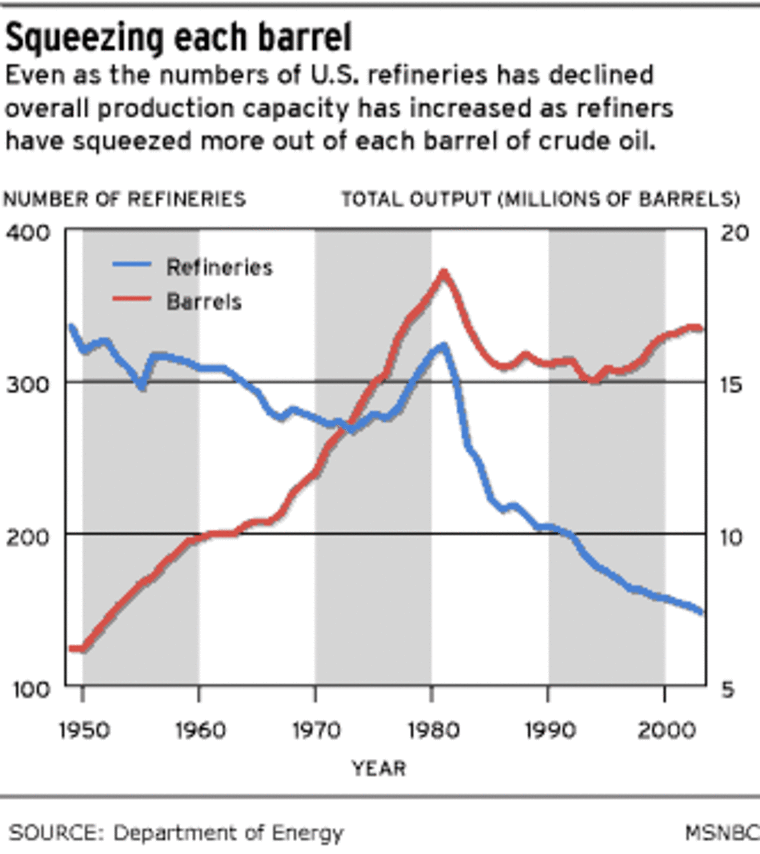The forest of oil refining towers on this sprawling industrial complex on Galveston Bay sits in the heart of the greatest concentration of refining capacity in the world. Roughly half of the gasoline consumed in the U.S. is made along this stretch of Gulf coast from Corpus Christi, Texas to New Orleans.
At the Valero refinery here, miles of pipe snake through the complex in a maze of loops and neat, right-angle turns that surround and connect the towers. This refinery processes nearly a quarter of a million barrels of crude oil every day. And general manager Ralph Phillip is always looking for ways to squeeze a little more through those pipes.
“Over time, if you’re a good businessman, you say: ‘Okay, I’ve got this facility, and I’m making 160,000 barrels a day,” he said on a recent tour. “’If can make 170,000, it’s worth this much money. Where do I go do that — if I can find that bottleneck in my refinery and spend some money to fix that?’”
Fixing those bottlenecks is more important than ever as the U.S. gasoline market winds down from a summer of record breaking prices — as ever-growing demand reached the limits of the country’s refining capacity. As tight inventories and fears of supply interruptions sent prices soaring this spring, U.S. refiners stepped on the gas pedal.
“We had such great prices and great (profit) margins for refiners that they ran as hard as they could in the second quarter and produced tremendous amount of product — one of the strongest quarters ever, if not the strongest,” said Jacques Rousseau, an analyst who follows the refining industry at Friedman, Billings, Ramsey.
But even as the peak summer driving season winds down, U.S. refiners continue to operate nearly flat out. As of this week, the industry is producing gasoline and other end products at something like 98 percent of capacity. And with the overall growth in demand for motor fuels and heating oil showing no signs of slowing, prices will continue to be driven as much by tight refining capacity as by the recent run-up in crude prices. Heating oil inventories are roughly at average levels for this time of year, but prices continue to climb. That’s due in part to concerns that prices could spike on any interruption in production — anything from a longer-than-scheduled maintenance shutdown to emergency repair or fire.
But the solution — boosting refining capacity to allow a greater margin for error — isn’t easy. There hasn’t been a new refinery built in the U.S. since 1976, the result of extremely tight environmental restrictions, not-in-my-back-yard community opposition, and the high cost of new construction. Used refineries currently sell for about 30 to 50 percent of the cost of building a new one, so it’s cheaper to buy an old refinery and upgrade it. Or squeeze a little more gasoline out of the refineries you already own.
Expansion of refining capacity is also made more difficult because oil refineries are a lot more complicated to build and operate than your average widget factory. For starters the raw material — crude oil — has many different properties, from thickness to sulfur content, so not all refineries can blend just any barrel of crude.
That crude — and the products it produces — range in temperature from zero to 1400 degrees during the process. Operating pressures range from 10 pounds to 1500. Then there are the many different products that can be distilled from that barrel of crude — from gases like propane, to lighter liquids like gasoline and diesel fuel, to the heavier “residual” fuels used by power plants or ship boilers, to asphalt and “coke” — the hard black substance left after you’ve pulled everything else out of the oil.
“Different refineries — depending on how much money has been spent on them — and what processing units they have — have greater flexibility to make larger amount of gasoline out of a barrel of oil than others,” said Phillip.

And there’s little consistency to a refiner’s biggest end product — gasoline. Beyond the familiar regular, mid-grade and premium grades, there are more than a dozen “formulations” — blends with a variety of additives designed to meet a patchwork of state-by-state clean air regulations, many of which can only be sold in specific regions. Not all refineries are set up to make all blends
The capacity squeeze is a relatively new phenomenon, according to Joanne Shore, a senior analyst at the U.S. Dept. of Energy.
“Until about the mid-1990s, we had too much capacity,” she said. “Demand finally grew into our capacity when we finally saw refiners run at full utilization after 1995, and then we started to see capacity increase again.”

Starting in 1997, capital spending by major oil companies surged to $12.1 billion in 2001, according to the Department of Energy. Much of that spending was driven by mergers and acquisitions. But the industry has also continued to make incremental improvements. Even though the total number of refineries continues to fall, overall output over the past decade has risen by the equivalent of a new medium-sized refinery every year, says Shore.
Some of the improvements are simple physical changes — a bigger “cracking” tower or higher capacity pipes or pumps. The Valero plant here recently added two “coking” units to squeeze more liquid fuel out of the “bottom of the barrel” solid material left over by the refining process.
Production output is also being expanded through technical improvements that allow refineries to operate more efficiently and reliably, thereby stretching out shutdowns for maintenance or repair. This fall, that scheduled maintenance is expected to cut into refining capacity by less than 5 percent of the nearly 17 million barrels a day of total output, according to A.G. Edwards refining analyst Bruce Lanni.
But expanding output may be getting harder to do. For starters, the cheapest bottlenecks have already been identified. Refiners have also recently been committing more money to upgrade facilities to meet tougher environmental regulations, according to Phillips.
“Right now there’s lot of investments that people are going to have to make around ultra-low sulfur fuel,” he said. “That’s a substantial investment. It’s going to be no capacity increase; it’s additional cost and processing. You have X amount of dollars to spend every year on new investment. For us, we’re spending on environmental improvements.”
Tighter environmental standards — or continuing efforts to maintain current standards with more cars on the road every year — may force more states to require “boutique” fuels that have to be blended specifically for one small region of the country. Those “islands” leave that region vulnerable to spot shortages that can quickly drive up prices.
“More states may choose or look at having islands of fuel to meet these new standards,” said Shore. “We are straining the distribution system, there’s not doubt about that. How far can we push it before we start to see more and bigger local volatility problems?”
The obvious solution — a single national fuel standard — isn’t as easy as it looks, said Shore. For one thing, the environmental challenges faced by different regions call for different solutions which a single blend might not be able to address. For another, the refining industry would have to make additional investments to re-tool to make that single blend — a process that would also take time.

In the meantime, the refining capacity squeeze in the U.S. is being made up by a growing level of imports — largely from refineries in Venezuela, the Caribbean and Europe. (Europeans use a greater proportion of diesel, said Shore, so those refiners have usually gasoline to spare for U.S. markets.) In recent years, imports have made about half the annual increase in demand, with expanded capacity making up the difference.
To meet continued growth in demand, Shore estimates the U.S. would have to boost refining capacity by another 250,000 barrels a day — every year. But it’s not clear just how much further U.S. refiners can stretch production.
“That’s the $64,000 question,” she said, “How much will imports increase and how much will capacity increase?”
(Next: